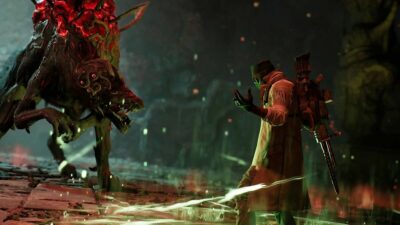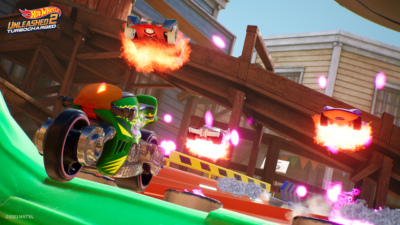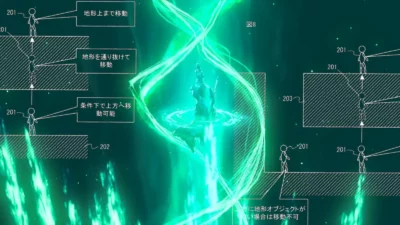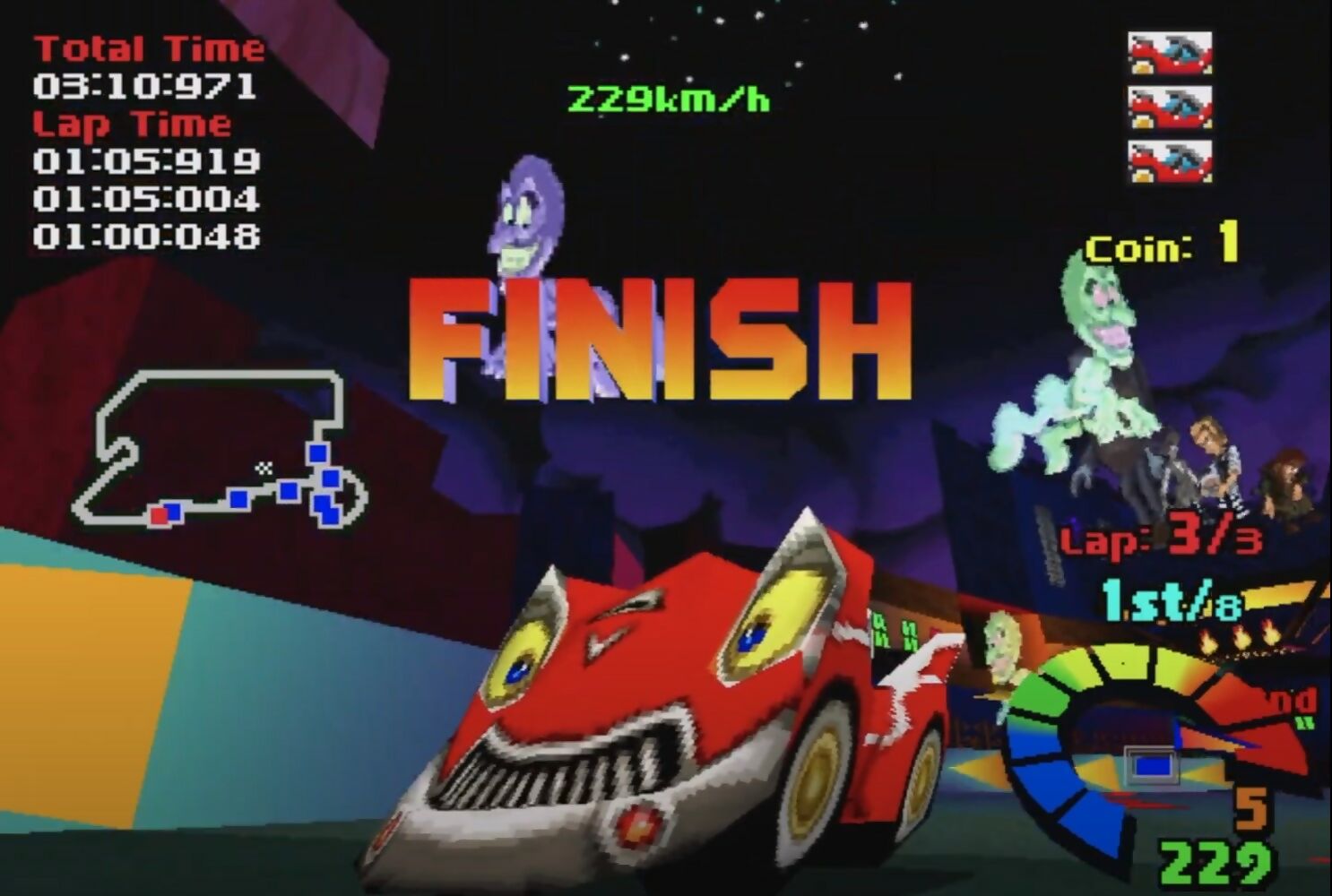
With the Gran Turismo movie in cinemas, we look at how Sony’s driving sim helped shunt the toon racer genre clear off the road.
If you’re non-driver like me, then you may find yourself underwhelmed by the release of the Gran Turismo movie, which came out in late August. Known in some territories as Gran Turismo: Based on a True Story, it tells the tale of Jann Mardenborough, a teenage gamer from Cardiff who got so good at the PlayStation 3 version of the game that, in 2011, he managed to forge a successful off-screen motorsport career, driving competitively for Nissan. How did Mardenborough monetise his own electronic sporting skills so successfully?
It was because the Gran Turismo games were supposed to be ultra-realistic driving simulators, rather than ordinary driving games as such, whose skills allegedly proved transferrable off-screen. Like Mardenborough, the game’s chief creator, Kazunori Yamauchi, is a petrol-head who also enjoyed a semi-professional racing career, apparently having competed in “the SP8 class in race 8 of VLN piloting a Lexus IS-F on the Nürburgring” in 2009, whatever that means (I think the basic gist is ‘he made a sports-car go really fast around a big track’).
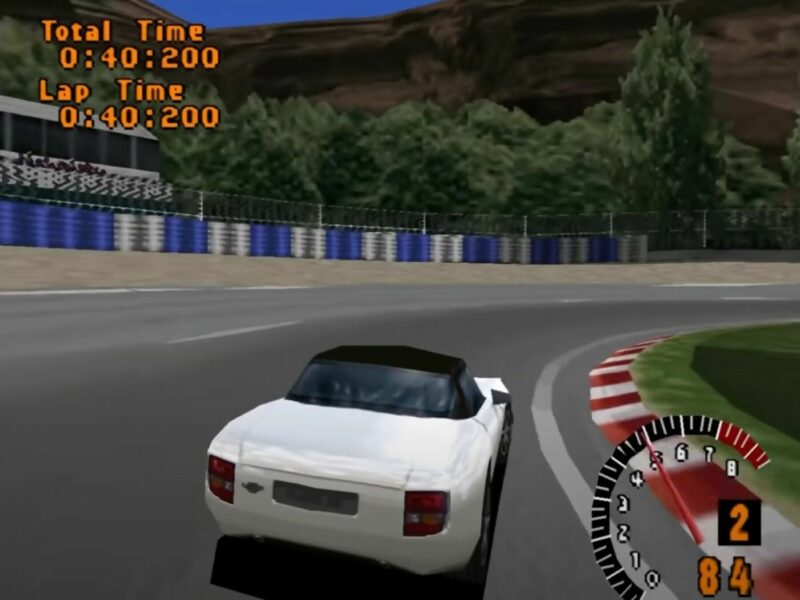
The original Gran Turismo, released in 1997. Credit: Polyphony Digital/Sony.
I like driving in my car
Yamauchi-san knows so much about cars, he makes Jeremy Clarkson sound like a small child going ‘brum-brum!’ while playing with a toy Tonka truck. The designer’s dream was to create a game in which you could drive a huge range of realistic-seeming, real-life cars around in such a way that controlling them on-screen was almost indistinguishable from driving them on actual roads.
As such, the first game, Gran Turismo, featured a then-astonishing 140 separate vehicles, each rendered with a then-equally amazing 300 polygons – and these weren’t just the usual super-cars like Ferraris and Aston Martins, but more humble, everyday vehicles players and their families would have driven to work, school or prison each day, such as Mitsubishi hatchbacks.
Uniquely, all cars handled precisely as they would have done on actual roads: Gran Turismo’s physics model was ultra-advanced for the day, taking into account things like suspension mechanics, weight distribution, tyre grip, gear shifts, front and rear-wheel drive, and various other things I have absolutely no concept of whatsoever. They even had cup-holders. Probably.
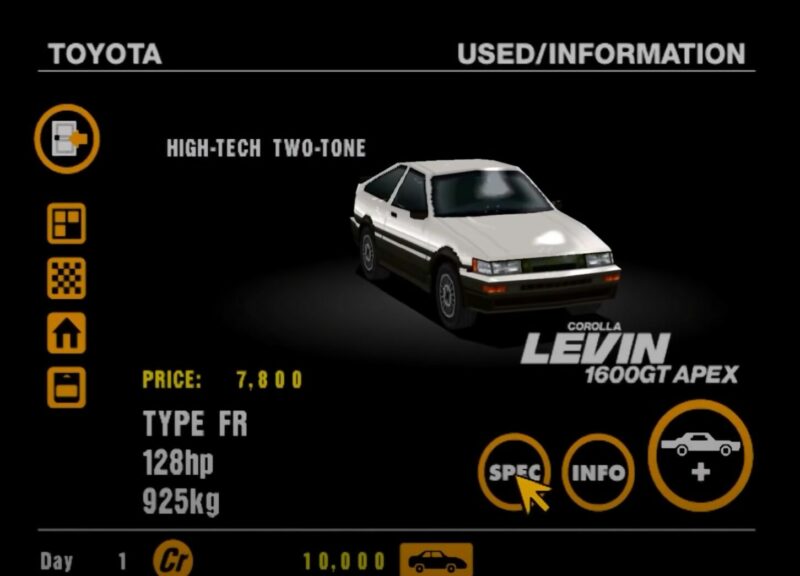
Uniquely for the time, Gran Turismo allowed players to drive more mundane hatchbacks and saloons as well as supercars. Credit: Polyphony Digital/Sony.
This all gave the game its tag-line of “the real driving simulator” and, by all accounts, GT was indeed very realistic: albeit, unlike a genuinely real “driving simulator” it did still make the key concession of being structured around players competing in racing contests rather than, say, taking trips to Ikea to buy a Billy Bookcase in their Ford Fiesta.
Also included was the innovative Simulation Mode, a sort of ‘CARPG’, where you began by only being able to afford a cheap wreck from your local dealership, before working your way up to buying a Lotus Esprit or something, with proceeds from your race winnings – an idea since copied by the game’s imitators.
Launched in Japan on 23 December 1997, Gran Turismo was a massive success, shifting 10.85 million copies worldwide, thus making it the biggest-selling game on the original PlayStation. As someone whose Platonic Ideal of a video game race-track is the Yoshi’s Island level in Mario Kart 8, though, I personally much prefer non-realistic racers like F-Zero, Micro Machines or Konami Krazy Racers to pretending to chug around some tarmac in a Ford GTi.
This is quite ironic, really, as Gran Turismo has its origins in just such a wilfully non-authentic series: the regrettably long-abandoned Motor Toon Grand Prix.
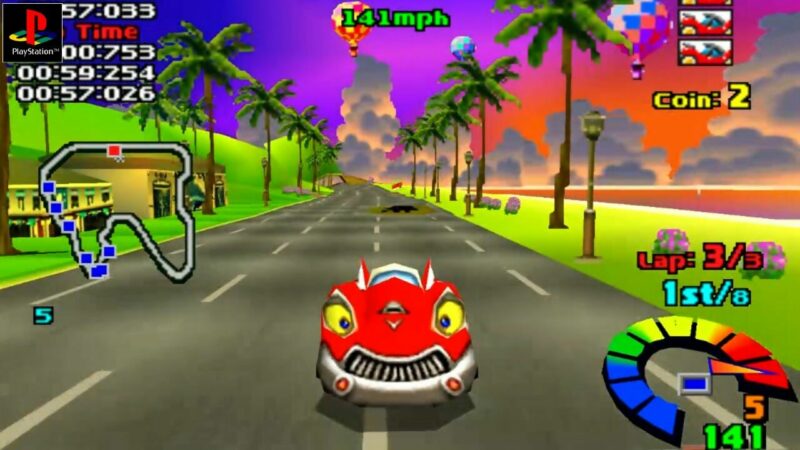
Psychedelic tracks and Looney Tunes eyes in the original Motor Toon Grand Prix. Credit: Sony.
Wacky races
In the lead-up to the launch of Sony’s PlayStation in late 1994, young employee Kazunori Yamauchi approached his superiors with an idea for a driving simulator – what would become Gran Turismo. His bosses said no. The PlayStation was a video game console. As such, they wanted a video game for it, not some boring vehicle simulator. They told Yamauchi to go away and make a Mario Kart clone instead, so he did, in the shape of Motor Toon Grand Prix. Released during the console’s domestic launch-window, the game never made it out of Japan for some reason.
In 1996, however, a sequel – known logically as Motor Toon Grand Prix 2 in Japan, Motor Toon Grand Prix USA Edition in the USA and simply Motor Toon Grand Prix in Europe – appeared, and was generally well-received. Although clearly not as good as the original 1992 SNES Mario Kart that inspired it, it was still good fun. To my jaundiced, car-illiterate eyes, its graphics have aged much better than those of GT itself, having a colourful, OutRun-type vibe on some of the courses, and a real Looney Tunes elasticity to the vehicles, which stretch impossibly like cartoons when they veer around corners.
Racers included such silly comic-book fare as the Penguin Bros, a pair of mafia penguins, Bolbox, a robot, Raptor and Raptor, a duo of aliens whose car drove faster in reverse-gear, and Ching Tong Chang whose name alone would now be enough to get his creators arrested. Racers could collect on-track coins to gamble on a roulette-wheel to gain power-ups like bombs, dynamite, 32-tonne weights and various other items sourced straight from the Warner Bros catalogues of Acme. So, all in all, not terribly true to life, then.
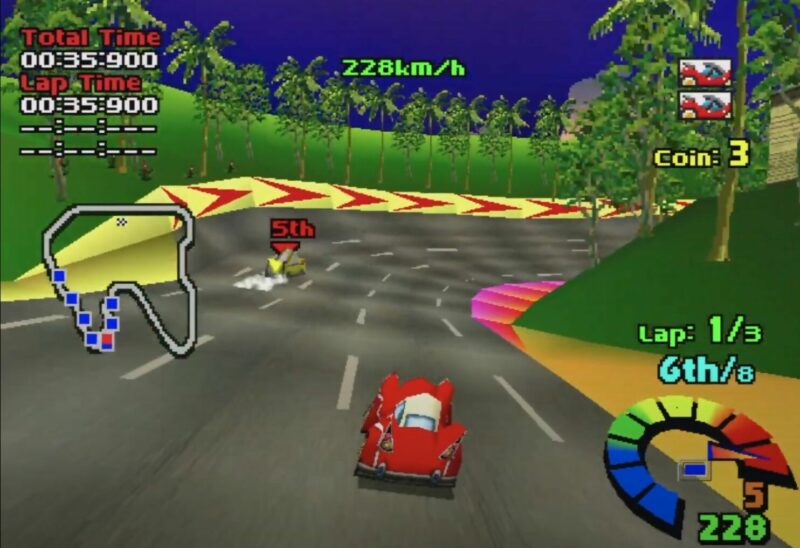
Cartoon racing, refined: it’s Motor Toon Grand Prix 2, as it was called in Japan. Credit: Sony.
Yet strangely, even here, the games were a sort of simulation – just not of reality. Instead, Yamauchi and his team had attempted to accurately simulate the sensation of controlling a remote-control toy car. “Basically, we’re not trying to fake reality,” he has said. “I’d rather create the sensation of handling a remote-control car but with the kind of dynamics that you’d expect from a real car. The cars’ suspensions actually work – we’ve attempted to simulate the dynamic forces as they go around corners.”
So, the realistic simulation of a non-realistic thing… Yamauchi just couldn’t help himself, could he?
Perhaps most interesting from a historical perspective, however, was that the second game in the series included an unlockable mini-game, Motor Toon Grand Prix R, which was basically a short demo for the game Kazunori Yamauchi really wanted to make, Gran Turismo. Here, you drove a realistic-looking F1 car or stock-car racer through one of the cartoon levels, using true-to-life vehicle physics. This was a final plea to Sony bosses to let Yamauchi make the real thing. Eventually, lest he lose his mind and run them all over in the company car-park one day, they said yes.
While making the Motor Toon games, Yamauchi and his team had secretly begun work on GT on the side anyway, and later actually used the physics engine from the appealingly childish ‘toon racer as the basis for their later, more po-faced driving simulator. Personally, I would rather the whole process had taken place the other way around. Nonetheless, GT’s success was immense, and changed the genre forever – but was this sudden gear-change really for the better?
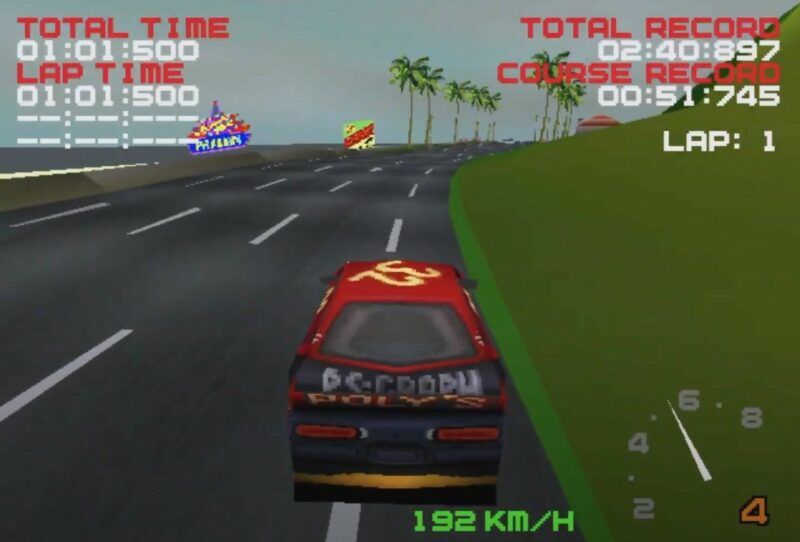
The seed that grew into Gran Turismo was arguably planted here, in Motor Toon Grand Prix 2’s brief Grand Prix R mode. Credit: Sony.
Stunt Car Racer
It is not as if Gran Turismo killed off ‘toon racer genre entirely – a little series called Mario Kart still exists and sells the occasional copy or two, and there are other cheery kart-racing competitors as well, not to mention those occasional more arcade-type experiences like Burnout and Crazy Taxi. But a whole genre placed aesthetically somewhere in the middle of Mario Kart and Gran Turismo once existed, too, and really does now seem to have been carted off to the scrapyard forever. The prime example would surely be Stunt Race FX (known as Wild Trax in Japan).
In Japan, the traditional native religion is Shinto, an animist creed holding that inanimate objects like rocks and rivers possess souls. Today’s motor vehicles are apparently no different, with Japanese car-makers still nodding to their traditional belief-systems by making the front-end of their products subliminally resemble faces, with the headlamps as eyes, grilles as mouths, and so forth. With Stunt Race FX, Nintendo took this trend to its logical conclusion, their classic 1994 SNES racer featuring cute little coupés, monster trucks and F1 cars with actual eyes for headlamps, as represented on the box and in adverts by sweet little clay models, like Morph with wheels.
Although it now seems graphically primitive, slow and filled with annoying pop-up – a souped-up update along the lines of the current-gen re-release of Sega’s Virtua Racing would do very nicely, thanks Nintendo – at the time, Stunt Race FX was technically impressive, using the in-cart SuperFX Chip add-on to allow the SNES to produce 3D polygonal cars and environments it would otherwise have been unable to manage.
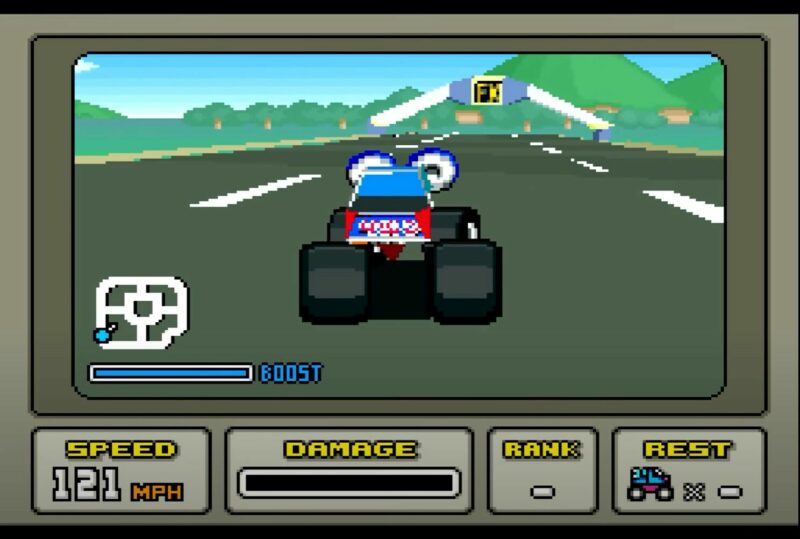
Stunt Race FX used the SuperFX chip to bring 3D racing to the aging SNES in 1994. Credit: Nintendo.
The title was a strange mixture of realism and fantasy; one the one hand, the different vehicles did have fairly realistic physics models for the day. On the other, they could extend their bodies vertically on jacks to avoid collisions, and the tracks were filled with cameos from the Arwing space-fighters from fellow SuperFX poster-boy Starfox, while the likes of Mario and Kirby stared down cheerily at you from billboards.
Track design was excellent, and the Free Trax time-trial mode particularly enjoyable; structured around a check-point system as in Virtua Racing, your main threat was running out of time before you hit the next progress-point. Elsewhere, you got to veer a scowling truck around a course hitting flags with your attached trailer. The game was a justified critical and commercial success, selling over a million copies, helped by the choking-hazard inclusion of a free themed Hot Wheels toy car in American Apple Jacks cereal boxes.
Read more: Burning Rubber | The race to recreate Burnout
The end of the road
So: yet another successful new franchise for Nintendo, then? Not really. At launch in mid-1994, Stunt Race FX looked incredible. By Christmas 1994, Ridge Racer had launched alongside the original PlayStation in Japan, suddenly making it look positively prehistoric, polygon-wise. Nonetheless, an N64 sequel was seemingly planned. Known as Buggie Boogie, the game was developed by an external US outfit, Angel Studios, who later went on to become RockStar San Diego, creators of Red Dead Revolver.
Buggie Boogie was an immensely troubled project which went through numerous different iterations, some of which featured grungy military-style vehicles, others of which contained brightly hued cars with cartoon eyes just like in Stunt Race FX (hence there is in fact some debate about whether it actually was a true sequel or not).
Whatever the game actually was, it seems to have been conceived as the original CARPG, a “DNA-based driving game” in which cars would zoom around, eat one another, and absorb their abilities like Kirby on wheels – a vehicular version of later GameCube curio Cubivore. At some points, these car-monsters were set to fight one another on big 3D battlefields. At others, they would race each other, gaining random DNA mutations from power-ups along the way, which would either help or hinder them on their way to the finish-line.
Sometime around 1997 or ‘98, however, development on the game was trashed when none other than Mario’s dad, Shigeru Miyamoto, turned up at Angel Studios to assess their work, deemed it to be “shit”, and suggested they create Nintendo a “fantasy golf game” instead.
What other successful racing game launched in 1997? Ah yes, Gran Turismo. I don’t wish to dispute that the GT series is a high-quality experience. It’s just that I’d much, much rather play a game in which cartoon cars with faces drive around eating each other to death instead. Isn’t that what video games are meant to be for? Providing players with experiences they can’t experience in real life, not ones they can?
If I wanted to drive a car, I’d learn to actually drive a real one, thanks very much, Mr Yamauchi.
Read more: WipEout | The modern racers continuing its anti-grav legacy



